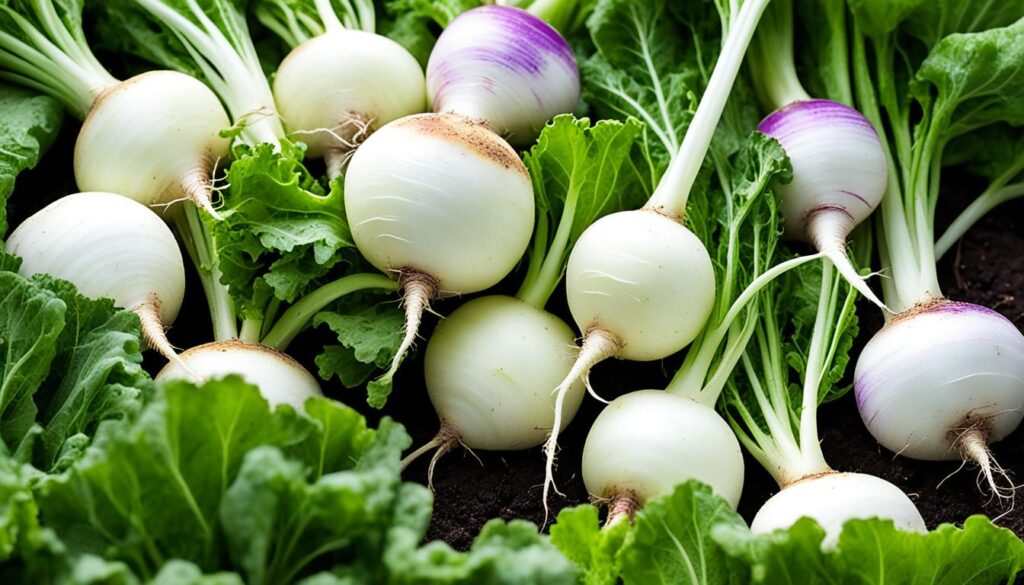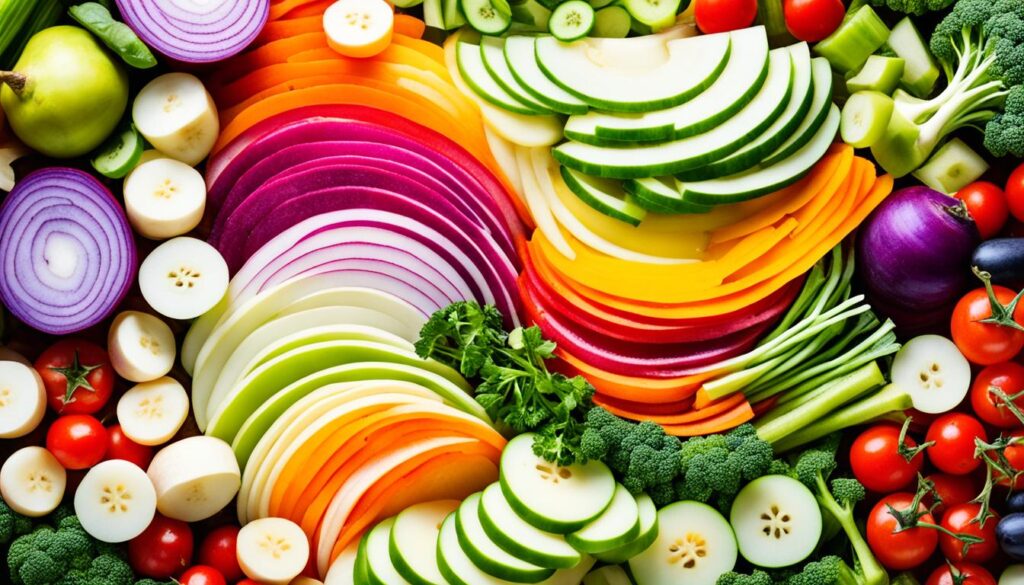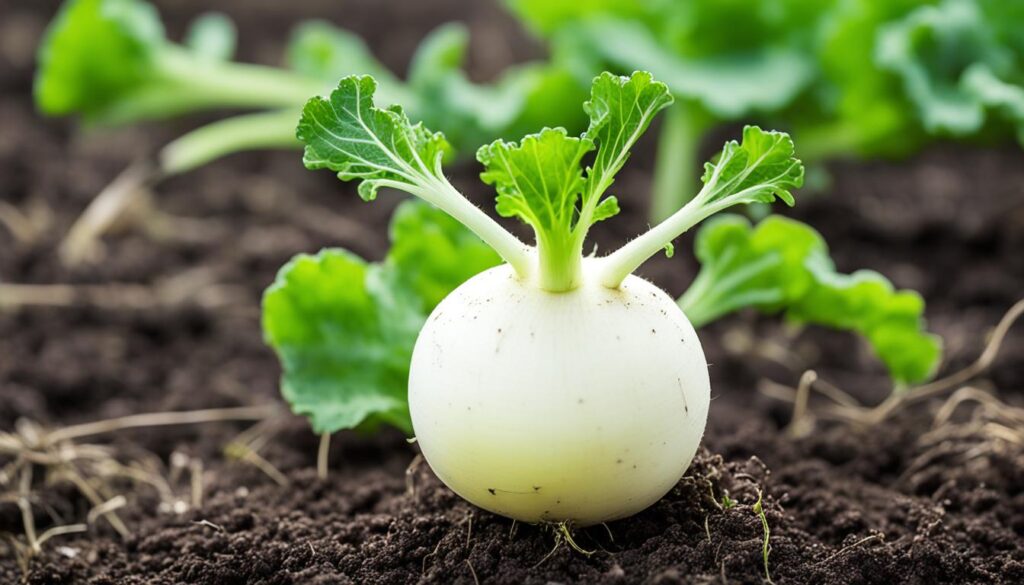Have you thought about growing turnips in your garden? These root vegetables are easy to grow and very nutritious. They belong to the Brassica rapa family and are great for winter. They should be a key part of your organic garden.
Imagine growing a vegetable that tastes great and is full of nutrients, perfect for cool weather. Turnips are this vegetable. They are rich in vitamins C and K, fiber, manganese, and potassium. Plus, their leaves are full of calcium, folate, and vitamins A, C, E, and B6.
Turnips: A Versatile and Underutilized Garden Gem
Planting and Growing Turnips
Turnips are a great fall vegetable that love cool weather. Plant them in late summer for a big harvest in fall. They need well-drained soil and lots of sun to grow well.
After planting turnip seeds, thin the seedlings to 3-6 inches apart when they are about 4 inches tall. This lets the plants grow big and strong. You can eat both the roots and the leaves of turnips. The leaves can be picked while the plant is still growing, but the roots might be smaller.
Turnips are very hardy and can be picked until the ground freezes. They get sweeter and tastier after a light frost. Whether you want to add turnip greens to salads or roast root vegetables, turnips are a great choice.

The Nutritional Powerhouse of Turnips
Turnips are a nutritional treasure, full of vitamins, minerals, and plant compounds. They are a great source of vitamin C. A cup of raw turnips gives you 27.3 mg, while cooked turnips offer 18.1 mg. Vitamin C boosts your immune system and fights off infections.
Turnips offer more than just vitamin C. They are also packed with fiber, manganese, and potassium. The Centers for Disease Control call turnips a «powerhouse fruit and vegetable.» This means they give you 10% or more of 17 important nutrients in a small serving.
| Nutrient | Amount per Serving |
|---|---|
| Calories | 36.4 kcal |
| Carbohydrates | 8.36 g |
| Total Sugars | 4.94 g |
| Fiber | 2.34 g |
| Protein | 1.17 g |
| Total Lipid (Fat) | 0.13 g |
| Sodium | 87.1 mg |
| Calcium | 39 mg |
| Phosphorus | 35.1 mg |
| Choline | 14.4 mg |
| Magnesium | 14.3 mg |
As a cruciferous vegetable, turnips are full of compounds that help prevent cancer. You can eat them raw or roasted. They are a great way to add nutrients to your meals.

Turnips: A Cruciferous Vegetable with Cancer-Fighting Potential
Turnips are not just tasty; they’re also packed with nutrients. They belong to the cruciferous vegetable family. This group may help fight cancer. Eating more turnips and similar veggies can lower the risk of stomach, breast, colorectal, and lung cancers.
Turnips have compounds like glucosinolates that slow down cancer cell growth and spread. Indole-3-carbinol and sulforaphane are key parts of these veggies. They are studied for their cancer-fighting abilities.
- Studies show that indoles and isothiocyanates can stop cancer in animals. They help protect organs like the bladder, breast, colon, liver, lung, and stomach.
- Human studies on these veggies and cancer risk have given mixed results. Some suggest they can protect against cancer.
- These veggies can change cancer-related markers in people. This might lower cancer risk.
Eating turnips and other cruciferous veggies often can lower cancer risk. Experts say eating a mix of veggies daily is good for you. Turnips are key in a diet that fights cancer.

Research on turnips and other veggies is promising. But, eating a balanced diet is best for your health. Talk to your doctor about adding these veggies to your meals.
Unleashing the Flavors: Cooking and Storing Turnips
Turnips are a versatile root vegetable that can be enjoyed in many ways. You can roast, boil, or sauté them. Proper cooking brings out their natural sweetness and texture. For a tasty side dish, try roasting white turnips at 400°F (200°C) for 25-30 minutes until they’re golden brown and tender. Turnip fries, on the other hand, bake up crispy and golden at 425°F (220°C) for 20-25 minutes.
To make a comforting turnip soup, simmer the roots in broth until they’re tender. Then, puree the mixture for a smooth, creamy texture. The greens can also be cooked and enjoyed, adding more nutrition to your meals. White turnips can be stored in a perforated plastic bag in the fridge for up to two weeks. Or, you can freeze them for up to six months after blanching.
Cooking Tips and Techniques
- Roast white turnips at 400°F (200°C) for 25-30 minutes until golden brown and tender.
- Bake turnip fries at 425°F (220°C) for 20-25 minutes until crispy and golden.
- Simmer turnips in broth until tender, then puree for a creamy, comforting soup.
- Store white turnips in a perforated plastic bag in the refrigerator for up to two weeks.
- Freeze turnips for up to six months after blanching for long-term storage.
Mastering cooking and storing turnips lets you enjoy this nutritious root vegetable all year. From roasted and crispy fries to comforting soups, there are endless ways to enjoy turnips. This makes them a great addition to any meal.
Turnips and Their Versatile Companion: Rutabagas
Turnips and rutabagas are both root vegetables. But they belong to different species. Rutabagas are Brassica napus, while turnips are Brassica rapa. They both love cool weather. But, they have some differences.
Rutabagas have a harder, yellow flesh. They need more time to grow. Harvest them in the fall after a frost for the best taste.
Turnips and rutabagas can be cooked in many ways. They are great together in the garden. Adding both to your meals makes them tasty and healthy.
| Characteristic | Turnips | Rutabagas |
|---|---|---|
| Appearance | Typically white with a purple top | Large, yellow-fleshed with purple accents |
| Texture | Tender, mild-flavored | Denser, more robust texture |
| Growing Season | Spring and fall | Longer, best harvested in the fall |
| Culinary Uses | Boiled, steamed, roasted, or raw | Boiled, mashed, roasted, or used in stews |
Turnips and rutabagas are in the Brassica family. They need similar conditions to grow as cool weather crops. Adding these root vegetables to your garden and kitchen brings variety. You get to enjoy different tastes and nutrients in the fall.
Pest and Disease Management for Healthy Turnip Crops
Keeping turnips healthy means watching out for pests and diseases. Flea beetles and cabbage maggots can harm turnips. Diseases like Alternaria leaf spot, black rot, and clubroot are also problems.
Common Pests and Diseases
Alternaria leaf spot is a big issue in cool, wet weather. Anthracnose waits in leaf debris and weeds, growing in moist, warm spots. Black root disease can live in soil for years.
Black rot appears in warm, wet places. Cercospora leaf spot does well in cool, wet weather. Clubroot can stay in soil for over a decade, spreading through contaminated soil and water.
Downy mildew likes cool temperatures and spreads fast in wet conditions. Sclerotinia rot, or white mold, comes out in moderate to cool weather and high humidity.



